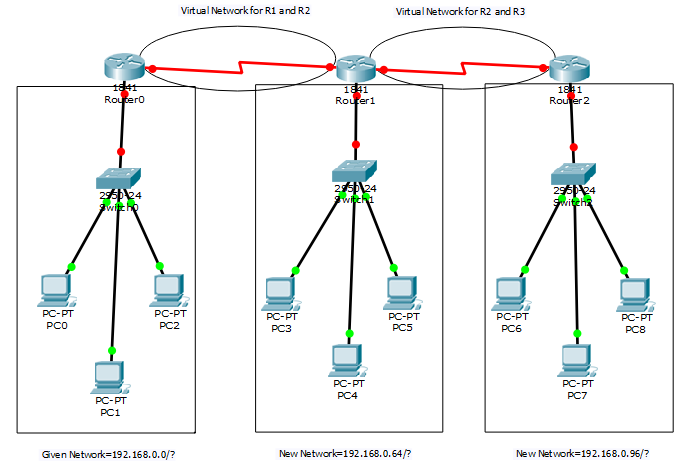Given Network = 192.168.0.0
Required hosts for Router 1 = 50
Required hosts for Router 2 = 20
Required hosts for Router 3 = 6

Router 1 >= 50 hosts
50 >= 2n – 2
50 >= 26 – 2
50 >= 64 – 2
50 >= 62
Total number of network bits = 32
32 – n = 32 – 6 = 26 (CIDR of Router 1 network i.e Given network )
i.e 192.168.0.0/26
N.S.M = 11111111.11111111.11111111.11000000
= 255.255.255.192
Block Size = 256 – N.S.M
= 256 – 192 = 64
Note: Add this block size in given network so that we can get our new network for Router 2.
so the new network is 192.168.0.64/?
Now find FVH, LVH and Broadcast address
Given network 192 .168 .0 .0
FVH 192 .168 .0 .1
LVH 192 .168 .0 .62
Broadcast 192 .168 .0 .63
New network 192 .168 .0 .64
Router 2 >= 20 hosts
20 >= 2n – 2
20 >= 25 – 2
20 >= 32 – 2
20 >= 30
Total number of network bits = 32
32 – n = 32 – 5 = 27 (CIDR of Router 2 network i.e New network )
i.e 192.168.0.64/27
N.S.M = 11111111.11111111.11111111.11100000
= 255.255.255.224
Block Size = 256 – N.S.M
= 256 – 224 = 32
Note: Add this block size in given network so that we can get our new network for Router 1 and 2 (Virtual Network).
so the new network is 192.168.0.96/?
Now find FVH, LVH and Broadcast address
Given network 192 .168 .0 .64
FVH 192 .168 .0 .65
LVH 192 .168 .0 .94
Broadcas 192 .168 .0 .95
New network 192 .168 .0 .96
Router 3 >= 6 hosts
6 >= 2n – 2
6 >= 23 – 2
5 >= 8 – 2
6 >= 6
Total number of network bits = 32
32 – n = 32 – 3 = 29 (CIDR of Router 3 network i.e New network )
i.e 192.168.0.96/29
N.S.M = 11111111.11111111.11111111.11111000
= 255.255.255.248
Block Size = 256 – N.S.M
= 256 – 248 = 8
Note: Add this block size in given network so that we can get our new network for Router 1 and 2 (Virtual Network).
so the new network is 192.168.0.104 /?
Now find FVH, LVH and Broadcast address
Given network 192 .168 .0 .96
FVH 192 .168 .0 .97
LVH 192 .168 .0 .102
Broadcast 192 .168 .0 .103
New network 192 .168 .0 .104
Router 1 & 2 >= 2 hosts (we required only two ip to connect 2 routers)
2 >= 2n – 2
2 >= 22 – 2
2 >= 4 – 2
2 >= 2
Total number of network bits = 32
32 – n = 32 – 2 = 30 (CIDR of Virtrual network (R1&R2))
i.e 192.168.0.104/30
N.S.M = 11111111.11111111.11111111.11111100
= 255.255.255.252
Block Size = 256 – N.S.M
= 256 – 252 = 4
Note: Add this block size in given network so that we can get our new network for Router 3. This network can be used in future.
so the new network is 192.168.0.108/?
Now find FVH, LVH and Broadcast address
Given network 192 .168 .0 .104
FVH 192 .168 .0 .105
LVH 192 .168 .0 .106
Broadcast 192 .168 .0 .107
New network 192 .168 .0 .108
Router 2 & 3 >= 2 hosts (we required only two ip to connect 2 routers)
2 >= 2n – 2
2 >= 22 – 2
2 >= 4 – 2
2 >= 2
Total number of network bits = 32
32 – n = 32 – 2 = 30 (CIDR of Virtrual network (R1&R2))
i.e 192.168.0.108/30
N.S.M = 11111111.11111111.11111111.11111100
= 255.255.255.252
Block Size = 256 – N.S.M
= 256 – 252 = 4
Note: Add this block size in given network so that we can get our new network for Router 3. This network can be used in future.
so the new network is 192.168.0.112/?
Now find FVH, LVH and Broadcast address
Given network 192 .168 .0 .108
FVH 192 .168 .0 .109
LVH 192 .168 .0 .110
Broadcast 192 .168 .0 .111
New network 192 .168 .0 .112

Basic configuration on Router 1
— System Configuration Dialog —
Continue with configuration dialog? [yes/no]: no
Press RETURN to get started!
Router>enable
Router(config)#hostname Mumbai
Mumbai(config)#interface fastEthernet 0/0
Mumbai(config-if)#ip address 192.168.0.1 255.255.255.192
Mumbai(config-if)#no shutdown
Mumbai(config-if)#exit
Mumbai(config)#interface serial 0/0/0
Mumbai(config-if)#ip address 192.168.0.105 255.255.255.252
Mumbai(config-if)#clock rate 64000
Mumbai(config-if)#no shutdown
Mumbai(config-if)#exit
Mumbai(config)#exit
Mumbai#write
Basic configuration on Router 2
— System Configuration Dialog —
Continue with configuration dialog? [yes/no]: no
Press RETURN to get started!
Router>enable
Router#configure terminal
Router(config)#hostname Thane
Thane(config)#interface fastEthernet 0/0
Thane(config-if)#ip address 192.168.0.65 255.255.255.224
Thane(config-if)#no shutdown
Thane(config-if)#exit
Thane(config)#interface serial 0/1/0
Thane(config-if)#ip address 192.168.0.106 255.255.255.252
Thane(config-if)#no shutdown
Thane(config-if)#exit
Thane(config)#interface serial 0/0/0
Thane(config-if)#ip address 192.168.0.109 255.255.255.252
Thane(config-if)#clock rate 64000
Thane(config-if)#no shutdown
Thane(config-if)#exit
Thane(config)#exit
Thane#write
Basic configuration on Router 3
— System Configuration Dialog —
Continue with configuration dialog? [yes/no]: no
Press RETURN to get started!
Router>enable
Router#configure terminal
Router(config)#hostname Pune
Pune(config)#interface fastEthernet 0/0
Pune(config-if)#ip address 192.168.0.97 255.255.255.248
Pune(config-if)#no shutdown
Pune(config-if)#exit
Pune(config)#interface serial 0/1/0
Pune(config-if)#ip address 192.168.0.110 255.255.255.252
Pune(config-if)#no shutdown
Pune(config-if)#exit
Pune(config)#exit
Pune#write
Verification on Router 1
Mumbai#show ip route connected
C 192.168.0.0/26 is directly connected, FastEthernet0/0
C 192.168.0.104/30 is directly connected, Serial0/0/0
Verification on Router 2
Thane#show ip route connected
C 192.168.0.64/27 is directly connected, FastEthernet0/0
C 192.168.0.104/30 is directly connected, Serial0/1/0
C 192.168.0.108/30 is directly connected, Serial0/0/0
Verification on Router 3
Pune#show ip route connected
C 192.168.0.96/29 is directly connected, FastEthernet0/0
C 192.168.0.108/30 is directly connected, Serial0/1/0
C 192.168.0.108/30 is directly connected, Serial0/1/0




